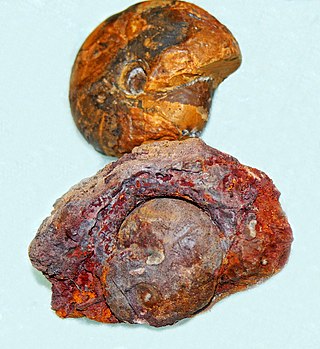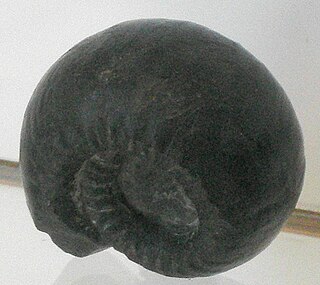
Ammonoids are extinct spiral shelled cephalopods comprising the subclass Ammonoidea. They are more closely related to living coleoids than they are to shelled nautiloids. The earliest ammonoids appeared during the Devonian, with the last species vanishing during or soon after the Cretaceous–Paleogene extinction event. They are often called ammonites, which is most frequently used for members of the order Ammonitida, the only remaining group of ammonoids from the Jurassic up until their extinction.

Goniatids, informally goniatites, are ammonoid cephalopods that form the order Goniatitida, derived from the more primitive Agoniatitida during the Middle Devonian some 390 million years ago. Goniatites (goniatitids) survived the Late Devonian extinction to flourish during the Carboniferous and Permian only to become extinct at the end of the Permian some 139 million years later.
Aquilonites is a pericyclacean goniatitid belonging to the family Intoceratidae, suborder Goniatitina, that lived during the very early Carboniferous of what is now Russia. [1]
Aristoceras is a Late Paleozoic goniatitid genus included in the Goniatitina suborder in which the lobes of the external suture are irregularly serrate.

Beyrichoceras is a genus belonging to the goniatitid family Maxigoniatitidae that lived during the Mississippian Period

Goniatitina is one of two suborders included in the order Goniatitida; extinct Paleozoic ammonoid cephalopods only distantly related to the Nautiloidea.
Adrianitoidea is one of seventeen superfamilies currently included in the Goniatitina, but only one of six there included in the Treatise, 1957. Shells are subdiscoidal to globose with variable umbilici and sutures with 10 to 30 lobes, which tend to be subequal.

Tornoceratina is one of two suborders included in the Goniatitida, characterized by generally involute, subdiscoidal shells and by sutures in which the ventral ones are undivided.
Prolobitidae is a family of middle and upper Devonian ammonoid cephalopods currently included in the goniatitid suborder Tornoceratina and superfamily Dimeroceratoidea, but previously included in the ancestral Anarcestida.
The Posttornoceratidae are Late Devonian goniatites (Ammonoidea) included in the superfamily Tornoceratoidea. The family, Posttornoceratidae, named by Bogoslovsky in 1962, is based on the genus Posttornoceras, named by Wedekind in 1910, originally included in the Tornoceratidae.

Gastrioceratoidea is one of 17 superfamilies in the suborder Goniatitina, ammonoid cephalopods from the Late Paleozoic.

Goniatitoidea, formerly Goniatitaceae in older publications, is a superfamily of late Paleozoic ammonoid cephalopods included in the Goniatitida. They are characterized by thinly discoidal to globular shells with variable umbilici and sculpture. The ventral lobe, located along the outer margin, is prominently bifurcated ; the lateral lobe undivided.

Neoicoceratoidea, formerly called Neoicocerataceae, is one of seventeen superfamilies of the Goniatitina suborder. Neoicoceratoidea comprises forms previously included in the Neoioceratidae and Metalegoceratidae, previously included in the Goniatitacae. These, along with new families defined for certain genera, including one from the Schistoceratidae, have been recombined as the Neoicocerataceae.
Thalassoceratoidea, formerly Thalassocerataceae, is a superfamily of Late Paleozoic ammonites characterized by their thick-discoidal to subglobular, involute shells with narrow or closed umbilici and biconvex growth striae with ventral sinuses. The ventral lobe of the suture, which straddles the outer rim, is wide, and bifid, with a tall median saddle.
Dimorphoceratidae is one of two families included in the Dimorphoceratoidea, a superfamily of ammonoid cephalopods belonging to the Goniatitida that lived during the Late Paleozoic. They are dimorphocerataceans in which the external lateral lobes and prongs of the ventral lobe are bifid. The shells are strongly involute, subdiscoidal to lenticular.
The Cravenoceratidae is one of six families included in the ammonoid superfamily Neoglyphioceratoidea, which lived during the latter part of the Paleozoic era.

Prolecanitida is an order of extinct ammonoid cephalopods, the major Late Paleozoic group of ammonoids alongside the order Goniatitida. Prolecanitids had narrow shells, discoidal (disc-shaped) to thinly lenticular (lens-shaped). They retained a retrochoanitic siphuncle, a simple form with septal necks extending backwards. As is typical for ammonoids, the siphuncle sits along the ventral margin of the shell.

Prolecanitoidea is a taxonomic superfamily of ammonoids in the order Prolecanitida. Prolecanitoidea is one of two superfamilies in the order, along with the younger and more complex Medlicottioidea. The Prolecanitoidea were a low-diversity and morphologically conservative group. They lived from the Lower Carboniferous up to the Middle Permian. Their shells are generally smooth and discoidal, with a rounded lower edge, a moderate to large umbilicus, and goniatitic to ceratitic sutures. Suture complexity varies from 10 up to 22 total lobes ; new lobes are added from subdivision of saddles adjacent to the original main umbilical lobe.
Cravevoceras is an Upper Paleozoic ammonite in the goniatite family Cravenoceratidae, probably derived from Pachylyroceras and contemporary with other cravenoceratid genera like Caenolyroceras, Tympanoceras and later Alaoceras and Lyrogoniatites. It is also a member of the Neoglyphioceratoidea.
The Uddenitinae a subfamily of the Medlicottiidae, a family of ammonoid cephalopods included in the Prolecanitida. The Uddenitinae, proposed by Miller and Furnish, and known from the Pennsylvanian and Lower Permian, are transitional between the ancestral Pronoritidae and the more traditional medlicottiids.







